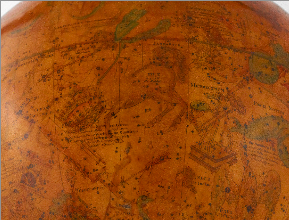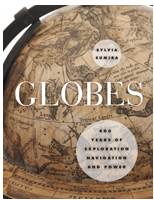The Celestial Sphere
By Sylvia Sumira (Guest Contributor)
 Celestial and Terrestrial Globes
Celestial and Terrestrial Globes
When one thinks of a globe, what usually comes to mind is a sphere showing the earth. But in the past, celestial globes were just as important as terrestrial ones. In fact, celestial globes, that is, those showing the visible stars, pre-dated terrestrial globes. Though the ancient Greeks postulated that the earth was a sphere as long ago as the sixth century BC, the first record of a globe being made refers to a celestial sphere made by Eudoxus of Cnidus in the fourth century BC.
Early Globes and the Farnese Atlas
The earliest surviving globe dates from around 150 AD and is known as the Farnese Atlas. It is a carved marble celestial globe which depicts the figure of Atlas carrying the sphere of the Heavens on his shoulders. Constellations were devised as an aid to remembering and pin-pointing the positions of the stars. We still use the constellations formed in ancient times. Forty-eight classical Greek constellations were recognized by Claudius Ptolemy (c. 90-168 AD) whose main works, the Geographia, a description of the known world, and the Almagest, a treatise on astronomy, became vital reference works for the creative thinkers in late 15th and 16th century Europe. This was also the time when exploration of the world took off and as sailors from Europe travelled ever farther south, they saw stars which are not visible from northern latitudes. Astronomers compiled new star catalogues from observations by sailors and new constellations were invented, many of which survive today. For example, Crux (the Southern Cross) was first described by Amerigo Vespucci (after whom America was named) in 1503. Other constellations came and went: Renne (the Reindeer) was formed in 1736 by the astronomer Pierre Charles Lemonnier and appeared briefly on globes, but did not survive for long. If one looks closely at the southern hemisphere of celestial globes made after 1760, nestled in amongst the older constellations of animals and birds, one can see Microscopium (the Microscope), Telescopium (the Telescope), and other instruments and tools of the Age of the Enlightenment, all invented by the French astronomer Nicolas de Lacaille after cataloguing the southern stars in the 1750s.
So, the pattern of stars in the sky may be constant but how we organize them into constellations has evolved over time. Now there are eighty-eight ‘official’ constellations – at least for the time being.
Sylvia Sumira is an independent conservator specializing in printed globes. She worked in globe conservation at the National
 Maritime Museum, Greenwich, London for several years and spent a period of study at the Austrian National Library in Vienna before setting up her own studio. She carries out work for museums, libraries and private clients. Her book
‘Globes – 4oo Years of Exploration, Navigation and Power’
has recently been published by the University of Chicago Press.
Maritime Museum, Greenwich, London for several years and spent a period of study at the Austrian National Library in Vienna before setting up her own studio. She carries out work for museums, libraries and private clients. Her book
‘Globes – 4oo Years of Exploration, Navigation and Power’
has recently been published by the University of Chicago Press.
Wonders & Marvels is thrilled to be able to give away three (3) copies of Sylvia Sumira’s GLOBES! To enter, please subscribe to our Book Giveaways here!“Book Club” subscribers will also receive updates on all upcoming giveaways.
The entry period ends 11:59pm EST on July 31.
(Currently, we can only ship to winners in the US)
Like what you’re reading? Subscribe to our newsletter below!
Subscribe to our mailing list
* indicates required
Email Address *
How often would you like updates? (check one)
Monthly Digest
Weekly Digest
Posts as They Happen (2-3 times a week)
var err_style = '';
try{
err_style = mc_custom_error_style;
} catch(e){
err_style = '#mc_embed_signup input.mce_inline_error{border-color:#6B0505;} #mc_embed_signup div.mce_inline_error{margin: 0 0 1em 0; padding: 5px 10px; background-color:#6B0505; font-weight: bold; z-index: 1; color:#fff;}';
}
var head= document.getElementsByTagName('head')[0];
var style= document.createElement('style');
style.type= 'text/css';
if (style.styleSheet) {
style.styleSheet.cssText = err_style;
} else {
style.appendChild(document.createTextNode(err_style));
}
head.appendChild(style);
setTimeout('mce_preload_check();', 250);
var mce_preload_checks = 0;
function mce_preload_check(){
if (mce_preload_checks>40) return;
mce_preload_checks++;
try {
var jqueryLoaded=jQuery;
} catch(err) {
setTimeout('mce_preload_check();', 250);
return;
}
var script = document.createElement('script');
script.type = 'text/javascript';
script.src = 'http://downloads.mailchimp.com/js/jqu...
head.appendChild(script);
try {
var validatorLoaded=jQuery("#fake-form").validate({});
} catch(err) {
setTimeout('mce_preload_check();', 250);
return;
}
mce_init_form();
}
function mce_init_form(){
jQuery(document).ready( function($) {
var options = { errorClass: 'mce_inline_error', errorElement: 'div', onkeyup: function(){}, onfocusout:function(){}, onblur:function(){} };
var mce_validator = $("#mc-embedded-subscribe-form").validate(options);
$("#mc-embedded-subscribe-form").unbind('submit');//remove the validator so we can get into beforeSubmit on the ajaxform, which then calls the validator
options = { url: 'http://wondersandmarvels.us6.list-man...?', type: 'GET', dataType: 'json', contentType: "application/json; charset=utf-8",
beforeSubmit: function(){
$('#mce_tmp_error_msg').remove();
$('.datefield','#mc_embed_signup').each(
function(){
var txt = 'filled';
var fields = new Array();
var i = 0;
$(':text', this).each(
function(){
fields[i] = this;
i++;
});
$(':hidden', this).each(
function(){
var bday = false;
if (fields.length == 2){
bday = true;
fields[2] = {'value':1970};//trick birthdays into having years
}
if ( fields[0].value=='MM' && fields[1].value=='DD' && (fields[2].value=='YYYY' || (bday && fields[2].value==1970) ) ){
this.value = '';
} else if ( fields[0].value=='' && fields[1].value=='' && (fields[2].value=='' || (bday && fields[2].value==1970) ) ){
this.value = '';
} else {
if (/\[day\]/.test(fields[0].name)){
this.value = fields[1].value+'/'+fields[0].value+'/'+fields[2].value;
} else {
this.value = fields[0].value+'/'+fields[1].value+'/'+fields[2].value;
}
}
});
});
$('.phonefield-us','#mc_embed_signup').each(
function(){
var fields = new Array();
var i = 0;
$(':text', this).each(
function(){
fields[i] = this;
i++;
});
$(':hidden', this).each(
function(){
if ( fields[0].value.length != 3 || fields[1].value.length!=3 || fields[2].value.length!=4 ){
this.value = '';
} else {
this.value = 'filled';
}
});
});
return mce_validator.form();
},
success: mce_success_cb
};
$('#mc-embedded-subscribe-form').ajaxForm(options);
});
}
function mce_success_cb(resp){
$('#mce-success-response').hide();
$('#mce-error-response').hide();
if (resp.result=="success"){
$('#mce-'+resp.result+'-response').show();
$('#mce-'+resp.result+'-response').html(resp.msg);
$('#mc-embedded-subscribe-form').each(function(){
this.reset();
});
} else {
var index = -1;
var msg;
try {
var parts = resp.msg.split(' - ',2);
if (parts[1]==undefined){
msg = resp.msg;
} else {
i = parseInt(parts[0]);
if (i.toString() == parts[0]){
index = parts[0];
msg = parts[1];
} else {
index = -1;
msg = resp.msg;
}
}
} catch(e){
index = -1;
msg = resp.msg;
}
try{
if (index== -1){
$('#mce-'+resp.result+'-response').show();
$('#mce-'+resp.result+'-response').html(msg);
} else {
err_id = 'mce_tmp_error_msg';
html = '
'+msg+'
';
var input_id = '#mc_embed_signup';
var f = $(input_id);
if (ftypes[index]=='address'){
input_id = '#mce-'+fnames[index]+'-addr1';
f = $(input_id).parent().parent().get(0);
} else if (ftypes[index]=='date'){
input_id = '#mce-'+fnames[index]+'-month';
f = $(input_id).parent().parent().get(0);
} else {
input_id = '#mce-'+fnames[index];
f = $().parent(input_id).get(0);
}
if (f){
$(f).append(html);
$(input_id).focus();
} else {
$('#mce-'+resp.result+'-response').show();
$('#mce-'+resp.result+'-response').html(msg);
}
}
} catch(e){
$('#mce-'+resp.result+'-response').show();
$('#mce-'+resp.result+'-response').html(msg);
}
}
}
// ]]>



